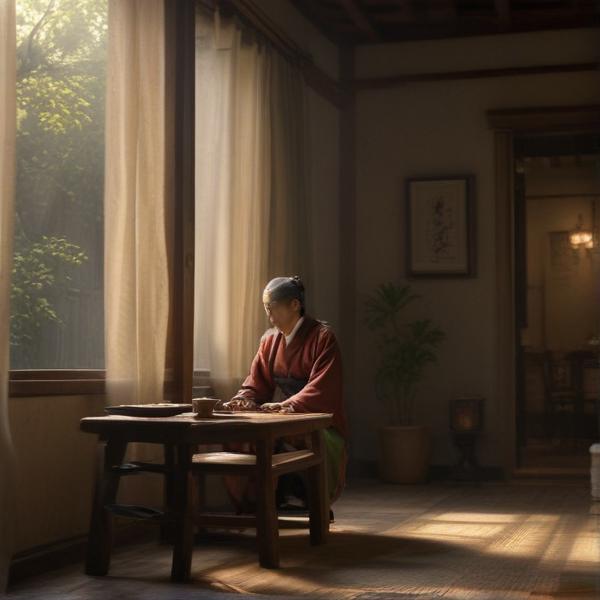基本信息 (Basic Information)
含义与用法 (Meanings & Usage)
中文核心释义 (Core Chinese Meaning): 憔悴,形容因为忧愁、劳累而显得面容枯槁。
英文核心释义 (Core English Meaning): haggard, withered (describing a person's worn and tired appearance due to anxiety or fatigue)
象形意义 / 为何这么写 (Pictographic Meaning / Writing Rationale)
文言文释义 (Classical Chinese Meaning)
与现代意义相近,常指因忧劳而面色憔悴。Similar to modern meaning, often describing someone appearing haggard because of anxiety or toil.
深入学习 (In-depth Study)
字源故事 (Origin Story)
字形演变 (Character Evolution)
常用词语和例句 (Common Words & Examples)
憔悴 (haggard; wan and sallow)
他因长时间劳累,显得十分憔悴。
Eng: He appeared very haggard due to long periods of fatigue.
枯悴 (withered; dried up and haggard)
植物因缺水而枯悴。
Eng: The plant became withered due to lack of water.
相关成语 (Related Idioms)
相关成语信息待补充。Related idiom information pending.
多语言翻译 (核心释义) (Translations (Core Meaning))
- French: hâve, exténué
- German: abgezehrt, ausgemergelt
- Spanish: demacrado, consumido
- Italian: smunto, sfatto
- Portuguese: macilento, exaurido
- Russian: измождённый, худой
- Arabic: شاحب، هزيل
- Persian: نحیف، پژمرده
- Dutch: verbleekt, uitgemergeld
- Polish: wymizerniały, wynędzniały
- Vietnamese: tiều tụy, héo hon
- Ukrainian: знесилений, схудлий
视频学习资源 (Video Learning Resources)
通过以下链接在热门视频网站搜索 "悴" 的更多讲解:
Search for more explanations of "悴" on popular video sites:
- 在 Bilibili.com 搜索 "悴 字源 说文解字" (Search on Bilibili)
- 在 YouTube.com 搜索 "cui character origin etymology" (Search on YouTube)
网络参考 (Web References for "悴") ()
网络内容摘要 (Web Content Summary):
-
核心含义:“悴”是一个形声字,从“心”,卒声。本义为“忧愁、悲伤”,引申为“憔悴”、“枯槁”。常用来形容因忧愁而面容枯槁或精神萎靡的状态。 Core Meaning: The character “悴” is a phonetic-semantic compound, with “心” (heart/mind) as the radical, expressing emotion or feeling, and “卒” as the phonetic component. Its original meaning is “sad, sorrowful,” and it later extended to mean “withered, gaunt, haggard.” It often describes being emotionally distressed and physically worn out.
-
文化背景与用法:古代文献中,“悴”常用于形容因灾难、困苦或忧虑而神色憔悴。如《史记》记载屈原“颜色憔悴”,《晋书》中说“百姓愁悴”。也可和“忧”、“愁”、“憔”等字混用,如“悴民”(忧愁不得志的人)、“悴沮”(忧伤沮丧)。 Cultural background & Usage: In classical texts, “悴” often describes people who have become haggard due to worries, disasters, or hardships. For example, in “Records of the Grand Historian,” Qu Yuan is described as “haggard in appearance.” It is often used alongside words like “忧” (anxious), “愁” (worried), and “憔” (withered), and appears in words like “悴民” (people distressed by hardship) and “悴沮” (dejected and sorrowful).
-
易混淆点与常用词:“悴”容易与“粹”(纯粹)、“翠”(青绿色)等形近字混淆,注意区分。常见搭配还有“憔悴”——专指面容和精神因忧愁、劳累等变得枯槁、瘦弱。 Easily confused characters & common collocations: “悴” is visually similar to characters like “粹” (pure) and “翠” (green/jade), so be careful not to confuse them. The most common collocation is “憔悴” (to look haggard or drawn, typically from worry or fatigue).
悴的解释|悴的意思|汉典"悴"字的基本解释 - 漢典
悴 cuì 〈形〉 (1) (形声。 从心,卒声。本义:忧愁,悲伤) (2) 同本义 [sad] 人力雕残,百姓愁悴。—— 《晋书·凉武昭王李玄盛传》 (3) 又如:悴民(指忧时而不得志的人);悴沮(忧伤沮丧) (4) 憔悴;枯萎 [be thin and pallied;withered] 屈原 …颜色憔悴,形容枯槁。 —— 《史记·屈原贾生列传》
漢語多功能字庫 - 字頭 「悴」 - humanum.arts.cuhk.edu.hk
」《方言》:「悴,傷也。 」如《呂氏春秋.順民》:「(越王)時出行路,從車載食,以視孤寡老弱之漬病困窮顏色愁悴不贍者,必身自食之。 」《鹽鐵論.論誹》:「洪水之災,堯獨愁悴而不能治,得舜、禹而九州寧。
更多图片 (悴 More Images) ()
